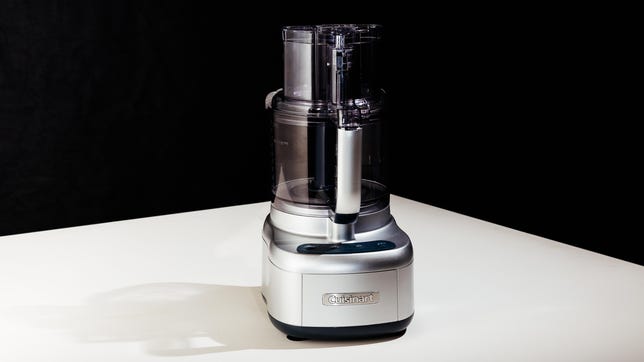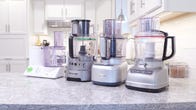In this article:
If you’re a hobbyist chef or an aspiring pro, one of the most versatile and useful appliances you can have in your home kitchen is a food processor. Not only are they a fancy blender for your countertop, they’re also capable of shredding cheese, grinding nuts, kneading bread and so much more. They’re the best little sidekick you could ask for, especially if you don’t have a personal sous chef.
That said, not every electric food processor is created equal — as with anything, there are stark differences in cost, motor performance and overall durability. It’s hard to jump in and figure out the best food processor for your chopping, grinding, dicing and food prep kitchen task needs. From motor power to capacity, attachments and overall value, we’re here to help you find the best available options and show you that the best food processors aren’t always the ones with the biggest price tag.
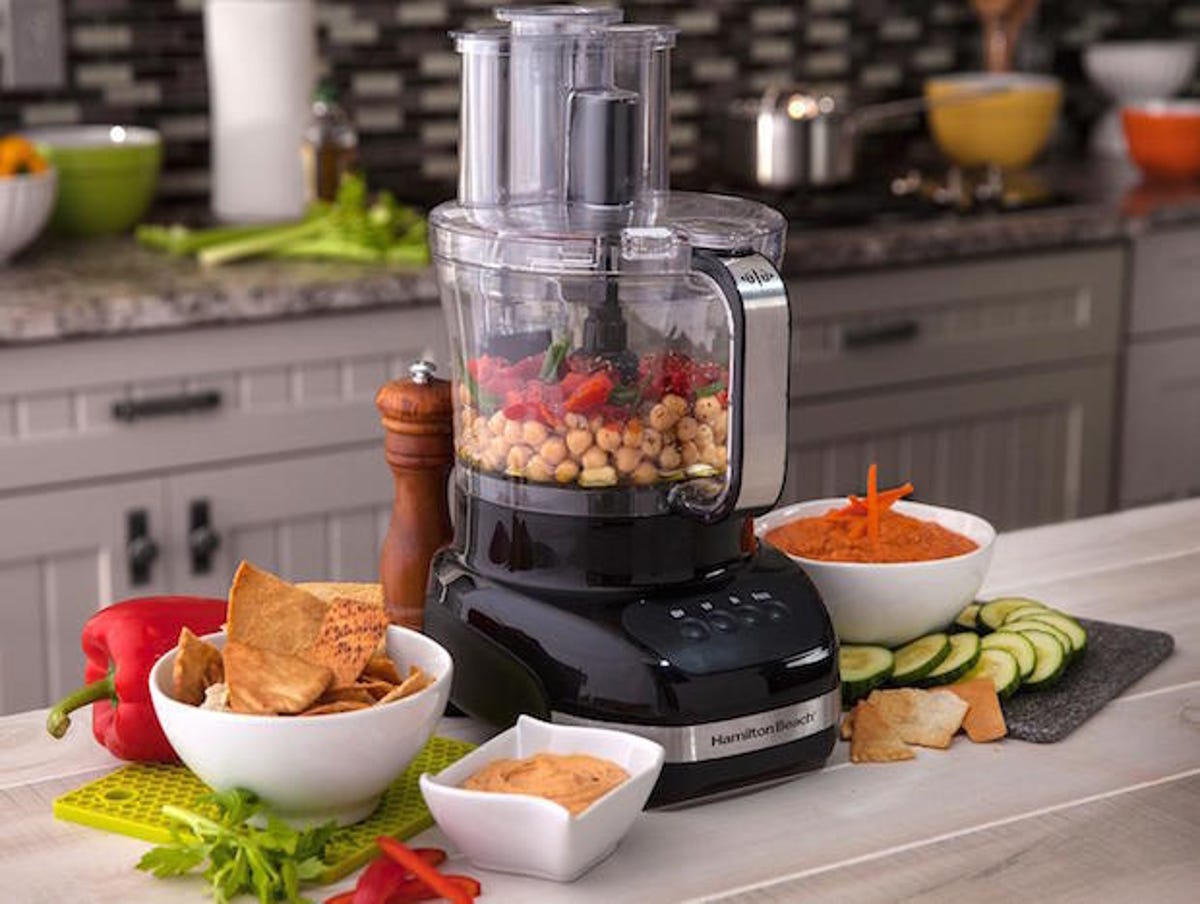
Food processors are one of the most versatile kitchen appliances.
Chowound
The other factor you might want to consider — beyond power and price tag — is how easy to clean the food processor is. Some or all of its components may be dishwasher-safe. Even if you have to hand-wash the chopping blade or slicing disk, being able to toss the feed chute or main container in the dishwasher may be a boon.
I tested seven food processors, representing major brands and best sellers according to Amazon, Target and Walmart buyer reviews. You can pick a food processor up for as little as $25 or splurge big on an expensive pro model for upward of $600. The food processors I tested are in the middle, mostly in the $100 to $200 range made for general home use. There are also mini models and extra-large food processors but the ones I tested are all average in size — between 10- and 14-cup capacities. You can also invest in a food processor attachment if there’s a particular kitchen task that you need it to perform.
Here’s how it all shook out and my recommendation for the three best food processors available, which we update periodically.
Best food processors
Tyler Lizenby/CNET
We tested multiple Cuisinart models and this one wins for its balance of performance, value and features. This Cuisinart food processor is also available in a smaller, 8-cup model.
Hummus with the Cuisinart Elemental FP-11SV was smooth and well-blended. Four pulses was enough to chop up my pico de gallo ingredients well, and although getting almonds to a butter consistency took significantly longer in this model (about 10 minutes on average), the result was smooth and well-mixed.
Shredding cheese was a bit tricky since the mouth of this processor’s food chute is small compared with other models. I had to trim down my wedge of Parmesan quite a bit to fit in the chute. However, you do get thoughtful extras like a disc with two shredding size options (fine or medium) and suction cups on the bottom of the processor to help it stay steady on your countertop. This food processor comes with 550 watts of power and a stainless steel chopping, mixing and dough blade. The stainless steel blade makes perfect dough for pasta and pie.
You’re receiving price alerts for Cuisinart FP-11SV Elemental Food Processor
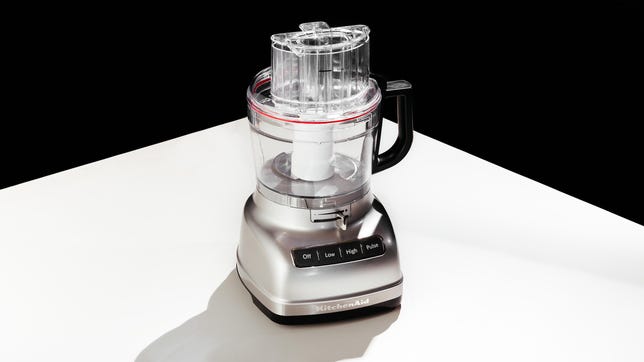
Tyler Lizenby/CNET
KitchenAid is a classic brand and while its stand mixers are beloved, I can’t say the same for the company’s food processor options. This 11-cup KitchenAid food processor model worked well, but it wasn’t the best performer at blending and chopping. However, you will get a lot of attachments, and it’s a good food processor for shredding and slicing since it comes with multiple discs for different shred and slice sizes.
Hummus made with this model had a smooth, well-blended consistency with even flavor. Five pulses of the chopping blade did the trick as a food chopper for my pico de gallo vegetables, and it easily processed almond butter, though the machine did heat up in the 18 minutes it took to process the almonds into nut butter, leaving me with questions about the motorbike. This KitchenAid model has an automatic shut-off to prevent motor burnout, but that heat still made me nervous.
Shredding and slicing are where KitchenAid really shines. It has a reversible shredding disc option and an externally adjustable slicing disc that corresponds to a slider on the front of the base, so you can get really specific slice sizes.
There’s also a nice storage case included, so you don’t end up throwing all those blades into your bowl when it’s not in use. It has a classic style and like any good KitchenAid appliance, it comes in multiple finishes. The price varies depending on which finish you choose. It typically retails for around $200, but right now you can pick it up for over half off the usual price.
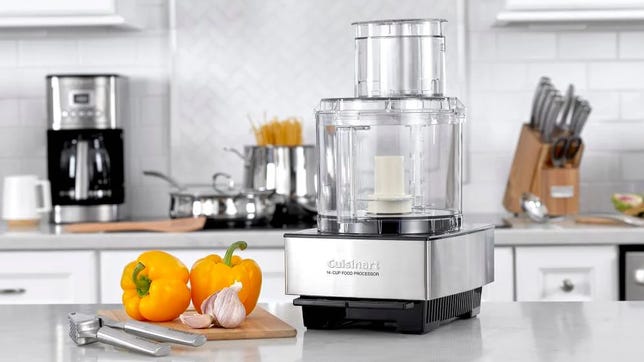
Cuisinart
If you need to process large amounts of food, this Cuisinart model with a 14-cup food processor gets the job done. Its sleek design looks good on your countertop and comes in multiple colors and finishes. With 14 cups of processing capacity, it’s the largest model we tested and slightly pricier than the other models we recommend.
While you do get large capacity and good performance, there’s only one speed option and the processor comes with only one shredding disc. For those reasons, it isn’t our top pick.
You’re receiving price alerts for Cuisinart DFP-14BKSY Custom 14-Cup
Other food processors we tested
In addition to the three recommended above, we also tested these food processors in the $100 to $400 range.
- Hamilton Beach Professional Dicing Food Processor (Update: Unavailable): I was impressed by the design of the Hamilton Beach processor, but it wasn’t the winner in performance, and I found the button labels and noise level to be a bit bothersome. At $350, I can’t recommend the Hamilton Beach Professional Food Processor over better-performing models.
- Ninja Smart Screen Blender and Processor: This kit comes with a blending bowl, processor bowl and a travel cup. With a smaller (5-cup) bowl capacity, results were inconsistent, and I would say it underperformed. The Ninja Smart Screen is a small food processor unit that I would avoid if your priority is food processing.
- Oster Designed for Life 14-Cup Food Processor: This food processor just didn’t perform well. Hummus had multiple unchopped chickpeas in it, and the gusty airflow out of the front of the machine was enough to blow around items on my countertop. Another food processor I would avoid.
- Braun FP3020 12-cup: This model was our original top recommendation, but it has since been discontinued. We haven’t tested other Braun models, but the brand is certainly worth looking into, especially if you find a good deal.
How we test food processors
While food processors can perform many different tasks, I chose tests that represent the core functions of a food processor. Most people use these kitchen appliances to blend, chop, puree and shred.
Having narrowed it down to these key kitchen tasks, I chose making hummus, pico de gallo, almond butter and shredded Parmesan for the test recipes. Those recipes involve a mix of blending, chopping, shredding and pureeing that would give me a feel for the performance of each model.
Hummus was a good indicator of how powerful a food processor’s motor was and thus how well the appliance could blend ingredients together into one smooth substance. Pico de gallo tested how easy it was for the chopping blade to create a uniformly chopped dish made up of ingredients in varying textures and hardnesses.
Almond butter allowed me to test the food processor’s ability to puree something like a hard almond into a nut butter consistency. It also required me to run the processor for an extended period of time to see if there were problems with overheating or noise and vibration. I used 16 ounces of almonds in each test.
The shredding test called for a nice big block of Parmesan, one of the hardest cheeses. This tests the grating disc performance as well as the usability of the mouth’s width and the food processor’s food pusher.
I repeated each recipe twice using each machine, with the same ingredients in the same amounts across all brands.
What to look for when buying a food processor
Picking the best food processor for you means considering all the features you’ll need for your favorite recipes and common home chef kitchen tasks.
Capacity
Food processors come in many different sizes and volumes. The size of the food processor is based on the size of the work bowl. I tested models ranging from 11- to 14-cup capacity, but you can get food processors that come with mini bowl and mini chopper options and bowls as small as 3 cups. For a household with two or more people, I’d recommend at least an 8-cup model rather than a mini food processor and, if you have the storage space, spring for a large food processor, just in case.
Speeds
Most recipes involving food processors specify mixing or chopping at either a high or low speed and for that reason, you’ll want a processor with at least two speeds and a powerful motor. The most common configuration is a low, high and pulse option. There are some food processors with just one speed, but that’s extremely limiting, so look for a food processor with at least some range of speeds.
My top food processor pick, the Braun FP3020, has 15 individual speeds on one dial. That’s many more than most people will ever need, but it permits real precision.
Attachments
While your food processor is primarily two spinning blades, there are plenty of other attachments that can expand your processor’s capabilities. Some come with multiple attachments like discs for grating, shredding and slicing, dough blades for kneading bread dough, and attachments for whipping cream, chopping nuts, juicing fruits or dicing vegetables. If you know what tasks you’ll do most often, be sure to check that your processor includes the blades and attachments you’ll need, such as the right mixing blade, chopping blade, slicing blade or citrus juicer. Some food processor models, like the Braun, come with a lot of these attachments, while for others they must be purchased separately. So depending on your food processing needs, this may be something to consider. Remember, attachments shouldn’t be difficult to clean, and you should definitely check whether they can go in the dishwasher.
Materials
You may also want to consider the materials from which the food processor is made. If you plan to use it often and are perhaps not the most careful chef in the kitchen, consider a sturdy stainless-steel food processor instead of one with a plastic base that may be less expensive but more prone to breakage. Most food processor bowls are made from a hard plastic that’s easy to clean and dishwasher-safe, but some are sturdier than others. If you have the opportunity to touch and hold the food processor before buying it, make sure the plastic bowl and its lid are tough enough to handle being knocked around without cracking.
Top food processors compared
|
Capacity |
14 cups |
11 cups |
11 cups |
|
Dimensions (depth, width, height) |
10.8 x 13.8 x 15.9 inches |
8.0×10.5×15.75 inches |
10.17×10.04×16 inches |
|
Number of speeds |
1 |
2 |
2 |
|
Weight |
18.2 pounds |
11.5 pounds |
12.4 pounds |
|
Watts |
720 |
550 |
360 |
|
Price |
$260 |
$150 |
$200 |

